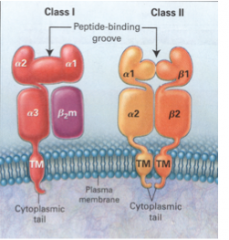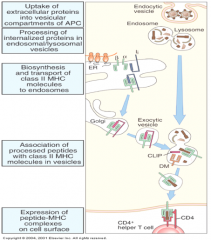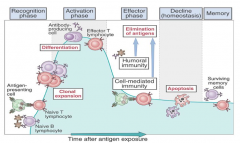![]()
![]()
![]()
Use LEFT and RIGHT arrow keys to navigate between flashcards;
Use UP and DOWN arrow keys to flip the card;
H to show hint;
A reads text to speech;
15 Cards in this Set
- Front
- Back
|
What are antigens?
|
-molecules recognized and responded to by B cell receptor (antibody) & t cell receptor
- may consist of soluble molecules or molecules belonging to whole cells - antibody, TCR recognize small molecular domains of antigen (not whole antigen) = antigenic determinants aka epitopes - antibody can recognize soluble antigens alone, but T-cell antigens are proteins and must be processed internally and presented by APC |
|
|
What are the 3 types of antigen presenting cells (APCs)?
|
1) dendritic cells (most potent activator of naive T cells)
2) macrophages 3) B cells |
|
|
What are the two "billboards" on APCs which present peptide antigens?
|
Class I and II major histocompatibility complex (MHC) molecules
|
|
|
How do T-cells recognize the antigen-MHC complex?
|
T-cell receptors
T-cells are grouped functionally according to class of MHC molecules that associate with the peptide fragments of the protein: 1) CD8+, cytotoxic T cells recognize class I MHC peptides 2) CD4+ helper T cells recognize class II MHC molecules |
|
|
What is the role of secondary lymphoid organs in antigen presentation and capture?
|
- antigen is picked up by dendritic cells (DC) which mature as travel to the lymph nodes (LN)
- maturation of DCs is reflected in upregulation of MHC mols and expression of costimulation mols such as B7 , which is required for T-cell response activation - the DC's present their peptides in the lymphoid organs to the T cells... if not for the lymphoid organs it would be difficult for dendrites to find T cells |
|
|
What are the MHC molecules?
|
- human MHC is also called human leukocyte antigen (HLA) complex
- class I genes consist of HLA-A, HLA-B, HLA-C loci; associated gene products are found on all nucleated cells and display peptide antigens for recognition by CD8+ T cells - human class II genes consist of D region (made up of HLA-DP, HLA-DQ, HLA-DR regions); associated gene products are found on antigen presenting cells & display peptide antigens for recognition by CD4+ T cells |
|
|
What is the significance of the "co-dominant expression" feature of MHC molecules?
|
- both parental alleles of each MHC gene are expressed
- this leads to increased number of different MHC molecules that can present peptides to T cells |
|
|
What is the significance of "polymorphic genes" in MHC molecules?
|
- many different alleles are present in the population
- ensures that different individuals are able to present and respond to different microbial peptides |
|
|
What is the significane of the 2 different MHC-expressing cell types?
|
- Class II: professional APCs, macrophages, B cells --> CD4+ helper T-cells interact with dendric cells, macrophages & B cells
- Class I: all nucleated cells --> CD8+ CTLs can kill any virus infected cell - CD4_ helper c |
|
|
What is the structure of the MHC complexes?
|

- class I/II MHC are membrane proteins containing peptide-binding clefts at the amino-terminal ends
-Class 1 - single transmembrane polypeptide w/ 3 extracellular alpha chain domains noncovalently attached to protein called Beta2-microglobulin (beta2m); class I molecules fold to form a binding groove b/w alpha1 & alpha2 domains that can FIT PEPTIDES OF 8-11 AMINO ACIDS; alpha3 is bidning site ofr T cell co receptor CD8 -Class II: 2 transmembrane polypeptide chains - alpha and beta; form binding groove that can fit PEPTIDES OF 10-30 AA's; Beta2 binds T-cell coreceptor CD4 -MHC molecules bind ONLY PEPTIDES not other types of antigens |
|
|
Which antigens are processed to bind to the MHC I complex?
|
-processing results in fragmentation of proteins, association of fragments with MHC molecules, expression of peptide-MHC molecules at the cell surface where they can be recognized by the T-cell receptor on the T cell
- class I: all nucleated cells, load intracellular peptides, recognized by CD8; known as "cytosolic or endogenous pathway"; - protein is derived from intracellular proteins and show what is going on inside the cell; targets are viruses living in cells, phagocytosed microbes in cytoplasm, proteins from altered host genes like tumors |
|
|
How are antigens processed and loaded into MHC I complex?
|
- ubiquitin-tagged proteins fragmented in cytosol by proteosome --> transport accross membrane of endoplasmic reticulum by a specialized transporter protein, called transporter associated with antigen processing or TAP --> w/i in ER, MHC class I alpha chain, B2m and peptide form stable complexes that are transported for display on the cell surface & are recognized by CD8+ CTLs w/i appropriate TCR
|
|
|
What are the characteristics of Class II MHCs?
|

- class II MHC molecules are found on APCs - macrophages, dendritic cells, B cells
- class II MHC molecules load extracellular peptides - class II MHC peptides are recognized by CD4 cells - peptides presente dare EXTRACELLULAR - called endocytic or exogenous pathway, but loading occurs intracellularly - peptides are endocytosed, digested in lysosomes, bound onto MHCII prior to being transported to cell surface |
|
|
How are peptides loaded into class II MHCs?
|
- exogenous proteins taken in by endocytosis are fragmented by proteases in an endosome
- alpha and beta chains of MHC II, along with an invariant chain, synthesized, assembled in ER & transported thru Golgi apparatus to reach endosome - in endosome, the invariant chain is digested leaving a peptide called CLIP (class II-associated invariant chain peptide) - molecule called HLA-DM facilitates exchange of CLIP for an antigenic peptide - peptide fragments from exogenous protein are able to associate with class II MHC molecules which are finally transported to cell surface and recognized by CD4+ t cells with appropriate TCR |
|
|
What are the phases of adaptive immune responses?
|

|

